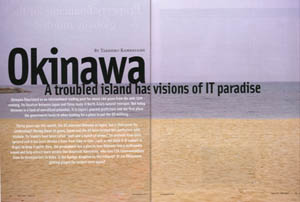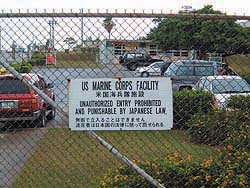OKINAWA: A Trouble island has visions of IT paradise
Back to Contents of Issue: May 2002
|
|
|
|
by Takehiko Kambayashi |
|
 "I WANT OKINAWA TO flourish in 20 to 30 years as it did during the era of the Ryukyu Kingdom," says Kuniharu Suzuki, head of the Multimedia Center in Nago, a city in northern Okinawa. Suzuki is part of a bold public and private attempt, called "the multimedia island concept," to resurrect Okinawa's proud trading past in the 21st century. "I WANT OKINAWA TO flourish in 20 to 30 years as it did during the era of the Ryukyu Kingdom," says Kuniharu Suzuki, head of the Multimedia Center in Nago, a city in northern Okinawa. Suzuki is part of a bold public and private attempt, called "the multimedia island concept," to resurrect Okinawa's proud trading past in the 21st century.
Suzuki and others envision Okinawa as an information technology hub in Northern Asia, linking powerful economies in South Korea, China, Taiwan and Japan. Suzuki says he expects the latest information technology to give a boost to sectors as diverse as education, medical services and farming throughout Okinawa, including its sparsely populated islands. But while the money is coming from Japan, the inspiration comes from farther afield. When it comes to IT advancement, "Japan has lagged behind other Asian countries," Suzuki says, so Okinawa is looking to the United States, Malaysia, India, Singapore and Ireland to learn how those countries advanced so quickly. The schools and municipal buildings of Nago are all connected with optical fibers. Sun Microsystems has donated 270 new computers as well. The city's Multimedia Center is surrounded by lush subtropical vegetation and azure waters. And businesses in Nago are eligible for a variety of special benefits, including tax breaks and subsidies on their payroll. The city is a living example of what the multimedia island concept is all about. Some people question whether such an out-of-the-way place needs a state-of-the-art facility built with government money. Suzuki defends his center by saying that it now accommodates branches of several companies that are creating much-needed jobs. And that's important in a prefecture that consistently has unemployment rates double the national average. Why has Nago received so much money and technology recently? The Japanese government has given hundreds of millions of dollars to Nago in exchange for accepting a new US military base, which will replace the US Marines' Futenma Air Base. Some of Nago's newfound wealth has come from the multimedia island concept. Under the plan, Okinawa, which has a population of 1.3 million, wants to boost employment in the IT industry from 10,000 as of last December to 24,500 in 2010. Okinawa has been coaxing companies to come to the island by offering them several incentives. For example, 30 percent of their young employees' salaries are subsidized by the Japanese government. The Okinawa government also covers 80 percent of companies' telecommunications expenses. These measures have helped increase the number of call centers on the island from three in March 1999 to 21 today, producing more than 3,500 jobs. Companies with a presence here include NTT, IBM, ORIX, KDDI and American Family Life Assurance. Local government officials and others who support the multimedia island concept say any sort of economic carrot should be thankfully received, considering the sad state of the Okinawan economy. "We very much welcome whoever kindly comes here," says Tsuyoshi Neha, a local government official working on the multimedia project. At first, call centers were all the rage since they produce a large number of jobs. Some Okinawans argue, however, that these are not the kind of jobs Okinawa really needs. "When you look at the reality of call centers, employees are paid only JPY600 or so an hour despite their hard work," says Yoshikazu Tamaki, an Okinawa assemblyman. "These jobs are here because labor is cheap. They are not employment in the true sense of the term." Call center salaries are often less than JPY150,000 a month. But other Okinawa officials argue that some companies offer employees relatively reasonable packages. Neha describes the multimedia project this way: "So far so good." Though Okinawa still lags behind the rest of Japan economically, many locals argue that the island has done pretty well during the past three decades considering its troubled past. Okinawa was annexed by Japan in the late 19th century, and it was the only part of Japan to experience ground combat during World War II -- some of the worst fighting of the war occurred there, leaving more than 200,000 dead. While the US military occupation of the rest of Japan ended in 1952, Okinawa was held for two more decades and still bears the brunt of the US military presence in Japan. The island, which constitutes less than 1 percent of Japan's territory, provides 75 percent of the land used in Japan for US military facilities. 
While residents in Okinawa have had to put up with the noisy and oppressive military presence, the American bases mean thousands of jobs and lucrative subsidies from the Japanese government. Jobs related to the US bases are an important part of the island's economy. So, even when the 1995 rape of a 12-year-old Okinawan girl by three US servicemen propelled many islanders to take to the streets to protest against the military presence and call for the removal of all the bases, some islanders worried that they did not have concrete ideas of how to replace those jobs on the bases should the US military actually leave. Hiroshi Hosaka, a professor of sociology and communications at the University of the Ryukyus, says that after the case, Okinawa learned three things: If the people are strong-willed they can get US military bases moved; Okinawa needs to develop its economy; the prefecture also needs to reduce the gap in economic development between the underdeveloped northern part of the prefecture and the south. The terrorist attacks on New York last September slammed the brakes on the Okinawan economy. The number of tourists visiting the subtropical island plummeted because of the heavy US military presence. The Okinawa government estimates that the attacks cost the prefecture JPY29.1 billion in lost revenue, as more than 247,000 people canceled trips to the prefecture. Once again, Okinawans were reminded just how vulnerable their economy is. Okinawa is now trying to get more jobs related to content production or software development from companies in Japan's urban areas. But experts say the island needs more skilled IT workers to make companies seriously consider relocating. Seiki Kyan, director of the Multimedia Education & Research Center at the University of Okinawa, Naha, says Okinawa needs to put much more emphasis on human resources development. The center, which was set up with the help of the Okinawa Electric Power Company, now offers local-government-subsidized courses from the Oracle Database and Cisco Network academies. Kyan stresses that the lack of IT engineers is a global phenomenon and the island's IT education should also be conducted in English to both lure foreign workers and train islanders to find jobs anywhere. His center is trying to network with universities abroad and US schools inside the bases in Okinawa, he says, in hopes of some day making Okinawa a hub of IT education in Asia. An international graduate school is being set up on the island for just this purpose, he says. "Okinawa should look overseas, especially focusing more on trade with other Asian countries, as it once did during the era of the Ryukyu Kingdom," Kyan says. "I kept hearing people say that it was difficult or even impossible to do business in Okinawa," says Kawamoto, president of CSK Communications (see "Call of the Wild," page 21). "But so many call centers have sprung up in one region in just three years. This is unprecedented in Japan." What will the next 30 years hold for Okinawa? Kawamoto replies: "A development that we could never imagine is now happening here, so no one can tell what the future holds" @ |
|
Note: The function "email this page" is currently not supported for this page.





